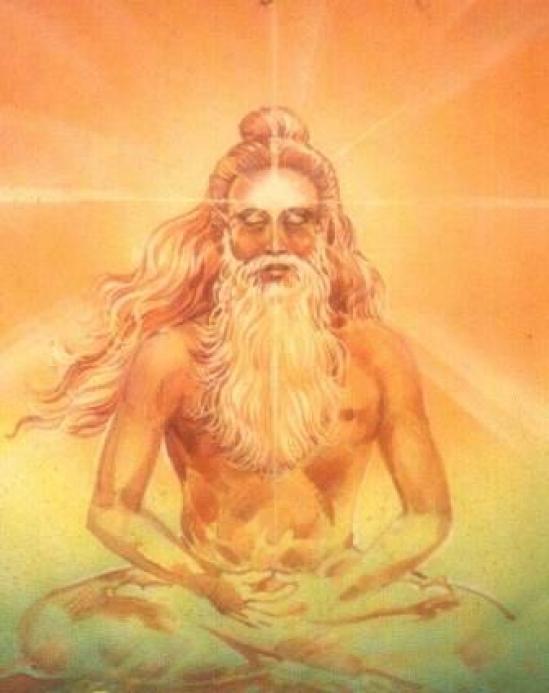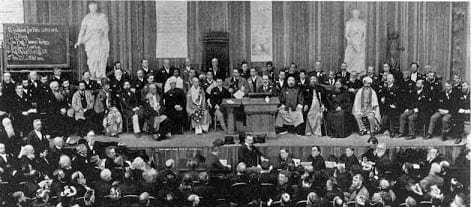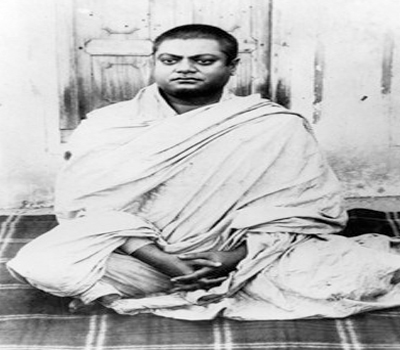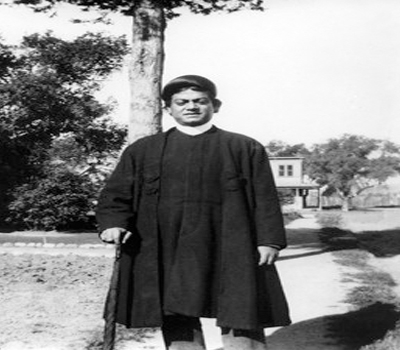ONE OF SWAMI VIVEKANANDA’S missions was to reinterpret and rejuvenate Vedanta for the modern times. His rereading of Vedanta, also called neo-Vedanta by some, bridges the microcosm and the macrocosm by showing that the transcendental Reality is immanent in each individual. Th e Upanishadic statement:‘ Tat tvam asi; you are That’, is brought home effortlessly and given a practical dimension assuring us that Truth is within everyone’s reach. With Vivekananda not only ‘Hinduism had been created’1 but Vedanta was given an expansive form encompassing all thoughts and faiths while welcoming new ones. He translated Vedanta into a language of freedom making it relevant to life. No one was worthless; every individual was a peephole to the infi nite. The final merging of the finite individual into the infinite is not an act of choice, it is inevitable, for the individual’s real nature is infinite.
Vedanta is broadly classified into dualism, qualified non-dualism, and non-dualism. While dualism and qualified non-dualism are based on concepts of a supreme God external to the jiva, individual self, non-dualism affirms the unity of the individual self and supreme Self. However, traditional non-dualism establishes this unity through a process of negation of the gross, subtle, and causal universe. If not practised in the proper spirit, this makes people apathetic to suffering by turning away from the grim realities of mundane life. The three main schools of Vedanta are portrayed as watertight by their adherents. Any attempt to synthesize them is scoffed at as a dilution and travesty of the philosophies. Consequently, these schools have traditionally remained at loggerheads with one another. While volumes have been written to establish the differences between them, little effort has been made to find similarities. It was left to Vivekananda and his inspiring words spoken with authority harmonized these three philosophies and thus redefined Vedanta for today.
Traditional Vedanta and Neo-Vedanta
To Vivekananda, Advaita Vedanta, non-dualism, was a universal philosophy not constrained by a particular religion, time, or space. He changed it from the traditional life-negation to life-affirmation and offered hope in finding the truth here and now. Vivekananda’s Vedanta is not different from the traditional Vedanta but is its fulfilment. A philosopher summarizes thus: ‘The neo-Vedanta is also Advaita inasmuch as it holds that Brahman, the ultimate reality, is one without a second ( ekam evadvitiyam). But as distinguished from the traditional Advaita of Shankara, it is a synthetic Vedanta which reconciles Dvaita or dualism and Advaita or non-dualism and also other theories of reality. So also it may be called concrete monism in so far as it holds that Brahman is both qualified and qualityless (saguna and nirguna), it has forms and is also formless (sakara and nirakara) .’2 Vivekananda showed us that the apparent and the real were two sides of the same coin; that the snake and the rope had the same substratum, that there was no phenomenon without the noumenon. Instead of harping on the unreality of the phenomenon, he wanted us to delve into the noumenon, the substratum.
He stressed on the spiritual identity of the individual. He wanted us to be strong and free from all false humility, mystery-mongering, and self-deprecating ideas, which kills faith in oneself. According to him: ‘He is an atheist who does not believe in himself. The old religions said that he was an atheist who did not believe in God. The new religion says that he is an atheist who does not believe in himself.’3 To Vivekananda all progress began with self-effort but the constant harping of individuals being nobodies was the cause of denigration of the human spirit. Hence Vivekananda ventured to revive the glory of the individual, which had been lost in doctrines that preached dependence, servility, and insignificance. The immortality of the Self was upheld and damnations and sins were denounced: ‘Ye are the Children of God, the sharers of immortal bliss, holy and perfect beings. Ye divinities on earth—sinners! It is a sin to call a man so; it is a standing libel on human nature’ (1.11).
Almost all of the traditional spiritual disciplines situate the truth outside the individual—the devotee was relegated to an inferior position and this relegation was itself considered a great spiritual practice. This approach was more objective than subjective. Vivekananda turned the emphasis back on the individual: ‘Studying the external alone, man begins to feel himself to be nothing … Therefore, it is not the study of external nature that makes [one] strong. But there is the internal nature of man—a million times more powerful than any volcanic eruption or any law of nature—which conquers nature, triumphs over all its laws. And that alone teaches man what he is’ (9.214). Vivekananda decried all forms of self-negation thus:
We have had weeping enough; no more is this the time for us to become soft. This softness has been with us till we have become like masses of cotton and are dead. What our country now wants are muscles of iron and nerves of steel, gigantic wills which nothing can resist, which can penetrate into the mysteries and the secrets of the universe, and will accomplish their purpose in any fashion even if it meant going down to the bottom of the ocean and meeting death face to face. That is what we want, and that can only be created, established, and strengthened by understanding and realising the ideal of the Advaita, that ideal of the oneness of all (3.190).
He stressed the need to turn the individual self away from unresponsive gods: ‘You have cried to all the gods in the world. Has misery ceased? The masses in India cry to sixty million gods, and still die like dogs. Where are these gods? … The gods come to help you when you have succeeded. So what is the use? … This bending the knee to superstitions, this selling yourself to your own mind does not befit you, my soul. You are infinite, deathless, birthless.’ (1.461).
This divinity of the self and the eradication of the distinction between the one and many could be considered the core teaching of Vivekananda. Sister Nivedita put it eloquently:
Swami Vivekananda who, while proclaiming the sovereignty of the Advaita philosophy, as including that experience in which all is one, without a second, also added to Hinduism the doctrine that Dvaita, Vishishtadvaita, and Advaita are but three phases or stages in a single development, of which the last-named constitutes the goal. Th is is part and parcel of the still greater and more simple doctrine that the many and the One are the same Reality, perceived by the mind at different times and in different attitudes; or as Sri Ramakrishna expressed the same thing, ‘God is both with form and without form. And He is that which includes both form and formlessness.’
It is this which adds its crowning significance to our Master’s life, for here he becomes the meeting-point, not only of East and West, but also of past and future. If the many and the One be indeed the same Reality, then it is not all modes of worship alone, but equally all modes of work, all modes of struggle, all modes of creation, which are paths of realisation. No distinction, henceforth, between sacred and secular. To labour is to pray. To conquer is to renounce. Life is itself religion. To have and to hold is as stern a trust as to quit and to avoid.
This is the realisation which makes Vivekananda the great preacher of Karma, not as divorced from, but as expressing Jnana and Bhakti. To him, the workshop, the study, the farmyard, and the field are as true and fit scenes for the meeting of God with man as the cell of the monk or the door of the temple. To him, there is no difference between service of man and worship of God, between manliness and faith, between true righteousness and spirituality. All his words, from one point of view, read as a commentary upon this central conviction.‘Art, science, and religion’, he said once, ‘are but three different ways of expressing a single truth. But in order to understand this we must have the theory of Advaita’ (1.xv-xvi).
To Vivekananda the jiva was journeying to its real individuality. Lest we mistake the nature of the individuality he clarified it: ‘In time we are to be individuals. But in what sense? What is the individuality of man? Not Tom Brown, but God in man. That is the [true] individuality. The more man has approached that, the more he has given up his false individuality. The more he tries to collect and gain everything [for himself ], the less he is an individual. Th e less he has thought of [himself ], the more he has sacrificed all individuality during his lifetime, … the more he is an individual. This is one secret the world does not understand’ (2.467–8).
Serving God in Humans: A Unique Philosophy
The general idea of seva, service, is that of well-off people helping the underprivileged. Vivekananda’s idea of seva was that of serving the divinity inherent in all beings. So, seva was not just helping others but a worship and also the service of one’s extended self. Swami Ranganathananda said:
Other human beings constituting the social environment are not just objects, are not just extensions of his natural environment, but are subjects like oneself; ethics, therefore, asks man to detach himself fr om his physical self and to view the social environment as it is in itself. This detachment helps him to liberate his higher self and view his social environment objectively. He then discovers anew that social environment consists not of objects but of subjects like himself. Th is is the discovery that led man to culture and civilization, to ethics and spiritual realization, that led him on the specifically human road of evolution.4
Vivekananda spoke about this spirit of seva:
Look upon every man, woman, and every one as God. You cannot help anyone, you can only serve: serve the children of the Lord, serve the Lord Himself, if you have the privilege. … Do it only as a worship. I should see God in the poor, and it is for my salvation that I go and worship them. The poor and the miserable are for our salvation, so that we may serve the Lord, coming in the shape of the diseased, coming in the shape of the lunatic, the leper, and the sinner! Bold are my words; and let me repeat that it is the greatest privilege in our life that we are allowed to serve the Lord in all these shapes.5
Vivekananda also converted the traditional four yogas into wonderful spiritual disciplines suited for the age. And this could be considered one of his significant contributions to Vedanta. He synthesized physiology, psychology, philosophy, and spirituality by making it easy and modern for the believers. Moreover, even atheists could practise yogas like karma and raja. The four yogas, he showed, are different facets of the human personality that can lead one to self-realization. The emotional, intellectual, active, and psychic faculties of the mind are channelled in bhakti, jnana, karma, and raja yogas respectively. A synergy of these yogas could quicken the attainment of the goal.
Closer to the Upanishads
Vivekananda’s approach was closer to the spirit of the scriptures—free from some conflicting meanings of the commentaries—and thus was a lucid exposition of Vedanta. He also wanted us to go to the original texts and find out the meaning for ourselves: ‘Go back to your Upanishads—the shining, the strengthening, the bright philosophy—and part from all these mysterious things, all these weakening things. Take up this philosophy; the greatest truths are the simplest things in the world, simple as your own existence. The truths of the Upanishads are before you. Take them up, live up to them’ (3.225). He asked us: ‘We need not go into text-torturing, we need not go into any sort of religious dishonesty, we need not go into any sort of grammatical twaddle, we need not go about trying to put our own ideas into texts which were never meant for them’ (3. 397).
Sri Ramakrishna reaffirmed and powered Vedantic traditions and Vivekananda gave us that relevant message. Speaking of the universality of Vedanta he said:
All of religion is contained in the Vedanta, that is, in the three stages of the Vedanta philosophy, the Dvaita, Vishishtadvaita and Advaita; one comes after the other. These are the three stages of spiritual growth in man. Each one is necessary. This is the essential of religion: the Vedanta, applied to the various ethnic customs and creeds of India, is Hinduism. The first stage, i.e. Dvaita, applied to the ideas of the ethnic groups of Europe, is Christianity; as applied to the Semitic groups, Mohammedanism. The Advaita, as applied in its Yoga-perception form, is Buddhism etc. Now by religion is meant the Vedanta; the applications must vary according to the different needs, surroundings, and other circumstances of diff erent nations. You will find that although the philosophy is the same, the Shaktas, Shaivas, etc. apply it each to their own special cult and forms’ (5.81-82).
Vedanta as envisioned by Vivekananda was thus the entire gamut of religion. After establishing it spiritually, intellectually, and morally, Vivekananda wanted to establish it scripturally, based on the major commentaries of the Acharyas Shankara, Ramanuja, and Madhva. He intended ‘to write a book … on the Vedanta philosophy’ (8.341), but alas could not complete this work. But this instead of being a loss has become an advantage, for by his life and works he left us the necessary framework for us to fill in the details and personalize Vedanta according to our individual needs and orientation.
Traditional spiritual practices were distinctively compartmentalized as spiritual and secular. One spent time in the morning and evening for spiritual practices and the rest of the day was seen as being spent on pursuits which were worldly. Th e aspirants were divided between the spiritual and the worldly. By putting human life in the right perspective, Vivekananda erased this division. According to him, life was a continuum of striving towards perfection. All beings, even a worm, are progressing towards unity: ‘The veriest worm will attain divinity, nay, is actually attaining it; you have got eyes, and don’t you see it?’ (6.294). According to him: ‘Man never progresses from error to truth, but from truth to truth, from lesser truth to higher truth—but it is never from error to truth’ (2.365).
In the words of Swami Ranganathananda:
We should distinguish between mere ethnical religion and spirituality, between static piety and dynamic spirituality. Religion as static piety means only that our name will appear in a particular column of the census register, as a member of a particular religious community, for instance, as a Hindu, a Muslim, or a Christian. We can all become this without any effort; we are all merely born into such religious communities. But so far as spirituality is concerned, we obtain it by seeking and inquiry; by such seeking, we grow, we develop, we unfold some profound truth hidden within us. This is what makes religion a science; nobody is born into physics or chemistry or other sciences; we seek it and achieve it.6
Vivekananda wanted Vedanta to be brought out of ancient texts and given a dynamic form, a form that reveals the infinite nature of the individual. He exhorted: ‘These conceptions of the Vedanta must come out, must remain not only in the forest, not only in the cave, but they must come out to work at the bar and the bench, in the pulpit, and in the cottage of the poor man, with the fishermen that are catching fi sh, and with the students that are studying. They call to every man, woman, and child whatever be their occupation, wherever they may be. And what is there to fear!’ (3.245).
While traditional doctrines insisted more on the precept than on the practice, for Vivekananda both the practice and the precept were important. Rather, he stressed more on practice: ‘Religion is realisation; not talk, nor doctrine, nor theories, however beautiful they may be. It is being and becoming, not hearing or acknowledging ; it is the whole soul becoming changed into what it believes. That is religion’ (2.396). Though the world has yet to imbibe the dynamism of Vivekananda’s wisdom, the work has already begun. His rereading of Vedanta has already started manifesting in the form of coming together of people of different religions, and also of science and Vedanta.
Vivekananda’s rereading of Vedanta has been considered as a new school of thought by some philosophers: ‘This may be taken as one of the best commentaries on the Vedanta. It synthesizes in a simple, straight, and sweet manner all the previous ones, bringing out their infinite wealth, inner beauty, and inherent glory. Swamiji had the head of Shankara and the heart of Sri Chaitanya; the eyes of a Monist and the hands of a Monotheist; the tenacity of a scholar and the tenderness of a lover; the devotion of a Theist and the spirit of service of a Humanist. We may call his interpretation of the Vedanta doctrine by a new name, “Manavadvaita-vada” or “Humanistic Monism”. For who has sung “manavamahatmya ” or the glory of man in sweeter tunes than he? ’⁷
Traditional Vedanta considered the world as unreal; Vivekananda’s Vedanta deified the world: ‘The Vedanta does not in reality denounce the world. The ideal of renunciation nowhere attains such a height as in the teachings of the Vedanta. But, at the same time, dry suicidal advice is not intended; it really means deification of the world—giving up the world as we think of it, as we know it, as it appears to us—and to know what it really is. Deify it; it is God alone.’8 This is the language of freedom that humankind can understand and respond to. This rereading of Vedanta is Vivekananda’s great contribution to the age and to humanity.
(Source: Prabuddha Bharatha January 2013)
References
1. The Complete Works of Swami Vivekananda, 9 vols (Calcutta: Advaita Ashrama, 1–8, 1989; 9, 1997), 1.x.
2. Dr Satischandra Chatterjee, ‘Vivekananda’s Neo-Vedantism and its Practical Application’ in Vivekananda: The Great Spiritual Teacher (Kolkata: Advaita Ashrama, 2008), 255.
3. Complete Works, 2.301.
4. Swami Ranganathananda, Philosophy of Service (Kolkata: Advaita Ashrama, 2007), 21.
5. Complete Works, 3.246.
6. Swami Ranganathananda, Eternal Values for a Changing Society, 4 vols (Bombay : Bharatiya Vidya Bhavan, 1993), 2.536.
7. Dr Roma Chaudhuri, ‘Vivekananda: His Place in Indian Philosophy’ in Vivekananda: The Great Spiritual Teacher, 295.
8. Complete Works, 2.146.
Related






Leave A Comment
You must be logged in to post a comment.